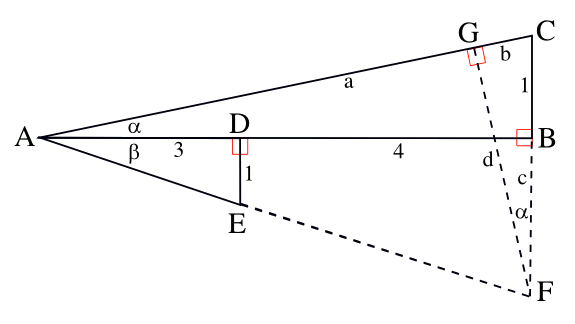Arctangent Diophantine Equations
April 9, 2012
The
natural numbers, which are the
counting numbers (one, two, three... and first, second, third...), are really useful things. The number, 0.25, can be expressed as 1/4; or, 2/10 + 5/100. You can see that any
real number can be expressed in this way, although some numbers will be harder to express than others, and
pi will take a little time.
The
mathematician,
Leopold Kronecker was a fan of the natural numbers. Kronecker said, "
God made the integers, all the rest is the work of man." This is a mathematical version of
Einstein's statement that
God doesn't play dice.
There are equations called
Diophantine equations that require
integer solutions. I mentioned Diophantine equations in a
previous article (The Lonely Runner Conjecture, August 11, 2011). The need for integer solutions to certain problems is illustrated by the
cattle problem, a Diophantine problem supposedly communicated by
Archimedes to his friend,
Eratosthenes. You wouldn't expect a fractional
cow to be grazing on the plain. A
spherical cow might be a special case.
A recent article on the
arXiv Preprint Server examines some
trigonometric Diophantine equations.[1] This paper, by Konstantine Zelator, a mathematician at
Bloomsburg University of Pennsylvania, examines
equations similar to the following:
 | (Eq. 1) |
There's apparently a
geometrical proof of this particular equation in a published paper, but the paper is not freely accessible online.[2] As a firm believer of the "
information wants to be free" principle, I've done my own proof. The geometrical construction for the proof is shown below.

Geometrical construction to prove that arctan(1/3) + arctan(1/7) = arctan(1/2). (Rendered by the author using Inkscape)
The arctan(1/7) and arctan(1/3)
triangles are ABC and ADE. Since you need a triangle that's the sum of the
angles, you obviously join the triangles together, as shown. To get the
tangent of the summed angle, you need to construct another
right triangle, AFG, as shown. The triangle ADE is
similar to the triangle ABF, and the triangle CFG is similar to triangle ABC. That knowledge, application of the
Pythagorean theorem, and a lot of calculation, proves the equation.
Although a
high school student would disagree, I find geometry to be fun. What I don't like is calculation, so I resort to
computer models, instead. The general form of Eq. 1, shown as Eq. 2, has many integer solutions. I've written a computer program to find them, and some of these are shown in the table. The
source code can be found
here. The one caveat, however, is that my equations are certain only within the limits of the
arithmetical precision. Since I checked the results using
Gnumeric, this is about one part in 10
16, but it isn't
mathematical certainty.
 | (Eq. 2) |
| α | β | γ | _ | α | β | γ |
| 2 | 3 | 1 | _ | 15 | 98 | 13 |
| 3 | 7 | 2 | _ | 17 | 41 | 12 |
| 4 | 13 | 3 | _ | 18 | 47 | 13 |
| 5 | 8 | 3 | _ | 22 | 75 | 17 |
| 5 | 21 | 4 | _ | 23 | 30 | 13 |
| 6 | 31 | 5 | _ | 23 | 83 | 18 |
| 7 | 18 | 5 | _ | 27 | 46 | 17 |
| 7 | 43 | 6 | _ | 31 | 43 | 18 |
| 8 | 57 | 7 | _ | 33 | 76 | 23 |
| 9 | 32 | 7 | _ | 34 | 55 | 21 |
| 9 | 73 | 8 | _ | 38 | 47 | 21 |
| 10 | 91 | 9 | _ | 47 | 83 | 30 |
| 11 | 50 | 9 | _ | 57 | 68 | 31 |
| 12 | 17 | 7 | _ | 57 | 73 | 32 |
| 13 | 4 | 3 | _ | 70 | 99 | 41 |
| 13 | 21 | 8 | _ | 80 | 93 | 43 |
| 13 | 72 | 11 | _ | 83 | 23 | 18 |
The
fractions, 1/α, 1/β and 1/γ, needn't have just 1 as a
numerator. Zelator offers Eq. 3 as an example. My computer offers Eq. 4, and many others.
 | (Eq. 3) |
 | (Eq. 4) |
References:
- Konstantine Zelator, "The Diophantine Equation arctan(1/x)+arctan(m/y)= arctan(1/k)," arXiv Preprint Server, March 28,2012
- Hasan Unal, "Proof without words: an arctangent equality," Mathematics and Computer Education, vol. 45, no. 3 (Fall 2011), p 197.
Permanent Link to this article
Linked Keywords: Natural numbers; real number; pi; mathematician; Leopold Kronecker; God made the integers, all the rest is the work of man; Einstein; God doesn't play dice; Diophantine equation; integer; Archimedes cattle problem; Archimedes; Eratosthenes; cattle; cow; spherical cow; arXiv Preprint Server; trigonometry; trigonometric; Bloomsburg University of Pennsylvania; equation; geometry; geometrical; proof; information wants to be free; Inkscape; triangle; angle; tangent; right triangle; similar triangles; Pythagorean theorem; high school student; computer model; source code; arctan.c; arithmetical precision; Gnumeric; Q.E.D.; mathematical certainty; fraction; numerator.